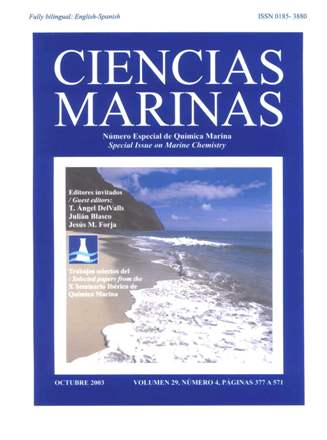Tidal transport of inorganic carbon and nutrients in a coastal salt marsh (Bay of Cádiz, SW Spain)
Main Article Content
Abstract
The Bay of Cádiz is surrounded by a broad zone of salt marshes that exchange water through a seawater channel 18 km in length (the Sancti Petri Channel). These littoral zones are characterized by their extreme shallowness (with a mean depth of less than 1 m) and their high content of organic matter, which in relative terms is highest in the surface sediments (between 1.2% and 2.6% organic carbon). Under these conditions, an intensive benthic regeneration of nutrients takes place, with mean fluxes in the zone of 83.2 ± 36.9 mmol m–2 d–1 of inorganic carbon, 6.36 ± 4.56 mmol m–2 d–1 of NH4+, 1.14 ± 0.56 mmol m–2 d–1 of HPO42– and 4.54 ± 2.25 mmol m–2 d–1 of SiO2. A proportion of these nutrients and inorganic carbon produced make their way through secondary channels to the Sancti Petri Channel, and the material is later transported by the tides to the Bay of Cádiz and other bordering littoral zones. In this work, the concentrations of inorganic carbon and nutrients (NH4+, NO2–, NO3–, HPO42– and SiO2) have been determined at three different depths, every hour, during complete tidal cycles. Simultaneously, the current velocities at different depths have been measured continuously. From this set of experimental data, calculations have been made of the evolution of the instantaneous velocities of these substances at each end of the channel, and by integration, the net balance for the complete tidal cycle. In general terms, there is an export of inorganic carbon and nutrients with the tides, although the net transports are very variable and depend to a large extent on the hydrodynamics of the zone. The results obtained correlate with balances previously made in the Bay of Cádiz.
Downloads
Article Details
This is an open access article distributed under a Creative Commons Attribution 4.0 License, which allows you to share and adapt the work, as long as you give appropriate credit to the original author(s) and the source, provide a link to the Creative Commons license, and indicate if changes were made. Figures, tables and other elements in the article are included in the article’s CC BY 4.0 license, unless otherwise indicated. The journal title is protected by copyrights and not subject to this license. Full license deed can be viewed here.

